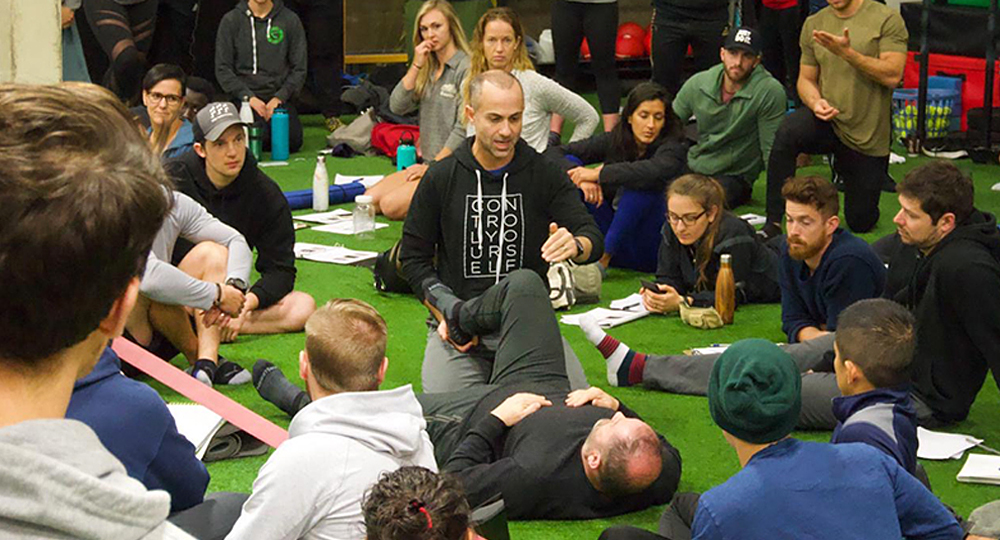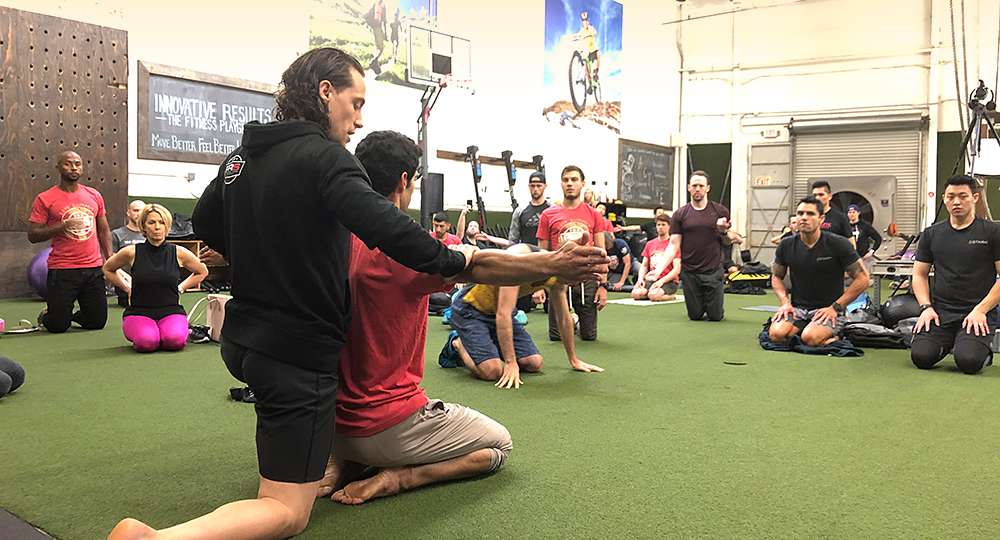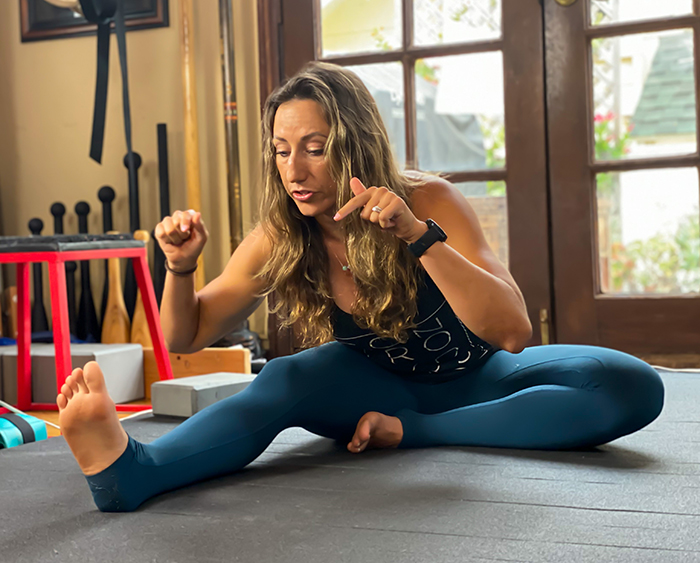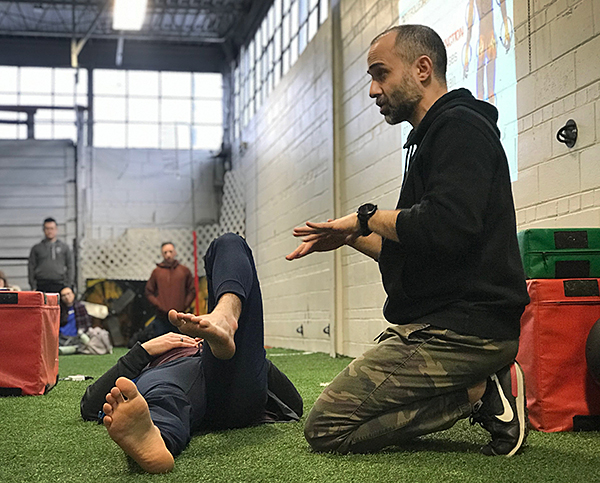What is FRC®?
Functional Range Conditioning, or FRC®, is a trademarked system of mobility and joint control training, which, unlike many current systems, is based in scientific principals and research.
Mobility, defined as the extent of controllable flexibility across articulations (flexibility plus strength), refers to the amount of USABLE motion that one possesses.


In any particular articulation there exists both a passive, as well as an active range of motion. The passive range refers to the angles that are only attainable through passive means (ie. The application of passive, external force). The term ‘flexibility’ has historically been synonymous with this concept and has been the focus of many athletes, trainers, therapists, sports medicine practitioners, and society as a whole. Reasons for this goal have historically included injury prevention, improving athletic performance, retarding the affects of aging, and developing long ‘athletic-looking’ bodies. However as with most physical exercise activities, stretching and flexibility training has long fallen into the realm of ‘gym science,’ while the true science has failed to be recognized. This has lead to the creation of flexibility training programs, which have been largely ineffective, misguided, dangerous…and that have failed to realize any of the desired goals.
Active ranges of motion are those ranges that are attainable through the application of active internal (muscular) force simulated by nervous system activity. It is these active ranges that can bestow the aforementioned benefits of injury prevention, improved performance (athletic and non-athletic), and lasting articular health.
Functional Range Conditioning (FRC®) utilizes the latest advancements in scientific knowledge, combined with tried and tested training methods to increase ones active, useable ranges of motion by simultaneously improving articular mobility, strength/resilience, and neurological control.
In essence, this invaluable, and innovative training system improves the ability to control, and move ones own body.
How does FRC® work?
FRC® works by systematically expanding the body’s ranges of motion, while simultaneously teaching the nervous system how to control the newly acquired ranges.
As our ability to generate force across the joint lessens, we lose the ability to actively control the range of motion. Thus these long, and short ranges are only accessible to us via passive means and are therefore essentially useless from a movement, functional perspective. Further, because the longer and shorter ranges are not utilized, the joints tissues never develop the ability to absorb loads at those ranges leaving them susceptible to injury.
Thus through specific, and safe training methods we are able to ‘capture’ passive ranges of motion and convert them into usable, active ranges. In addition, during the development of improved mobility, the system ensures the simultaneous development of tissue strength and resilience in the newly acquired ranges.
Benefits of FRC®
Mobility & Flexibility
Flexibility can be defined as the amount of passive movement available across an articulation. This range of motion is passive in that the body in unable to achieve it without the help of an externally induced force. Despite the historically overwhelming focus on its acquisition in health and fitness realms, flexibility in and of itself, does not improve function, or human movement as it represents joint positions that the nervous system is unable to control. Mobility on the other hand, defined as flexibility + control, represents the amount of usable motion across an articulation under the direct control of the central and peripheral nervous system.
It is the main focus of FRC® to both improve flexibility, as well as to simultaneously teach the nervous system how to control the newly acquired ranges. Further, the FRC® system provides strategies not only for the development “simple” control, but also for developing the ability to generate power, strength, and co-ordination, in said ranges. All of the aforementioned results allow any new ranges of motion to be integrated and utilized in functional movement patterning.
Joint Strength
Well known to the strength and conditioning community are the physiological benefits of physical training on the muscular system. However, the benefits can and should far exceed enhancements of this one tissue. Progressive loading also leads to cellular adaptations in the connective tissues of the body. Connective tissue, one of the four types of human biological tissues, includes the following types: Fascia, bone, ligaments, capsules, tendons, vessels and 80% of nerves.
With every bout of physical conditioning, each of the aforementioned tissues is affected, a fact forgotten by the majority of health and training professionals. With proper programming, keeping this concept in mind, the benefits of training can and should be inclusive of each of the tissues on this list. The FRC® system considers each of these subtypes as targets during training and ensures the attainment beneficial tissue adaptations and strength in each. FRC® thus improves tissue quality and resilience in ALL of the components making up the joint complex.
Articular Health & Longevity
The benefits of utilizing the Functional Range Conditioning™ mobility development system extend beyond athletic development, rehabilitative, and performance goals. In the process of developing mobility, all articular connective tissue components are strengthened, and neurological control of said tissues enhanced. These are two factors well known in the scientific literature to enhance joint health, prevent injury, and improve longevity. FRC has therefore been safely, and effectively utilized with several patient populations and ages to preserve movement and function, optimize joint health, and slow the progression of the degenerative process. Some of the components of the system, Controlled Articular Rotations (CARs)™ for example, were specifically created with this goal in mind.
Performance Enhancement
As FRC® improves ones mobility by increasing the functional ranges of motion across articulation, it allows improved utilization of potential to kinetic energy transfers. Put in another way, the more active motion that can be achieved across a joint, the more potential there is to store potential energy during a lengthening cycle, which can then be transferred into usable force during a shortening cycle.
Thus improvements in mobility unlock greater ranges of motion with which to develop force output. Improved mobility is also a vital component of agility, defined as the ability to rapidly respond to change by adapting its initial stable configuration. Agility can be though of as utilization of ones mobility, thus, just as with mobility itself, the acquisition of agility is a goal common to all sports and functional activities.
Rehabilitation and Prevention
Utilization of Functional Range Conditioning® is not limited to performance enhancement. Many of the techniques inherent to FRC® were originally developed for utilization in a clinical setting for injury rehabilitation and prevention.
FRC® creator, Dr. Andreo Spina, is a sports specialist Chiropractor, medical Acupuncturist, and Kinesiologist who has had experience treating a variety of patients ranging from professional and amateur athletes, to non-athletic populations, and everything in between. His creative, and groundbreaking techniques are now utilized by other practitioners worldwide who have studied and become certified in his assessment, treatment, and rehabilitative system FUNCTIONAL RANGE RELEASE (F.R.)® technique.
Dr. Spina views the process of assessment, treatment, rehabilitation, and training as a continuum. As such, many of the FR® and FRC® principles purposefully overlap.
Thus the concepts taught at FRC® certifications provide invaluable information, techniques, and insight regarding both injury rehabilitation, as well as prevention.


SIGN UP FOR AN FRC® SEMINAR TODAY
UTILIZED BY TOP PROFESSIONALS AROUND THE WORLD

















































